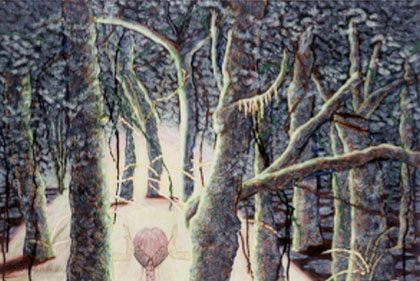Critique: Susan Michod's 9/11 Shroud Series
Gozamos, September 2011
Corey Nuffer
Michod's Work Can Be Judged...
Chicago Tribune 1995
Alan Artner
Susan Michod
ARTFORUM, March 1983
Judith Russi Kirshner
Susan Michod
new art examiner, November 1986
Susan Michod
Art News, November 1982
Ronny Cohen
Michod showcases range...
Chicago Sun-Times, Nov. 1986
Sue Taylor
Susan Michod
ARTFORUM 1978
C.L. Morrison
New Dimensions: Surface
August 10-October 7, 1979
Pauline A. Saliga
Chicago Tribune Art Review, 1995
Chicago Cultural Center
by Alan G. Artner, Tribune Art Critic

This is admirable, for while Michod has struggled with a life threatening illness, she has avoided creating work that takes illness as its subject and has thereby refrained from making what has become known as “victim art.”
Instead, Michod’s landscapes are repositories of feelings one might experience through illness, thought to viewers the feelings appear general, not resulting from a specific, identifiable cause.
This gives primacy to the emotions rather than the illness, which means the paintings have a better chance at achieving universality.
Whether Michod’s paintings do achieve it is, of course, something else. But in a time when art about breast cancer or AIDS automatically gains praise for its choice of subject, how much better it is to come across an artist who has not taken the easy route.
The most successful paintings are also the most recent, which are dominated by a forest motif in neo-expressionist style. But while these are greater in number, a lone example of a more minimal cast – and technically speaking, more drawing than painting- shows Michod worked in different styles concurrently.
Each of the forest pictures has a spectator who reacts in various ways to Michod’s maelstrom of strokes and blaze of light. The figure is a stand-in for actual viewers, that is, a member of the audience; but it is also the artist herself serving us as Virgil did Dante in the forest of the Inferno as a guide.
Michod’s more minimal pictures dispense with the figure, presenting only two apparently unrelated images, such as a coin and a woodpecker.
The overheated forest paintings achieve directness through the simplest means, which is to say, purely through paint. Several other works rely (far less successfully) on wooden fragments – frames, louvers – affixed to the surface.
The exhibition will continue at 78 E. Washington St., through Sept. 7.
Chicago Cultural Center
78 E Washington St
Chicago, IL 60602
